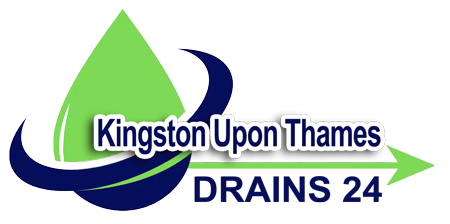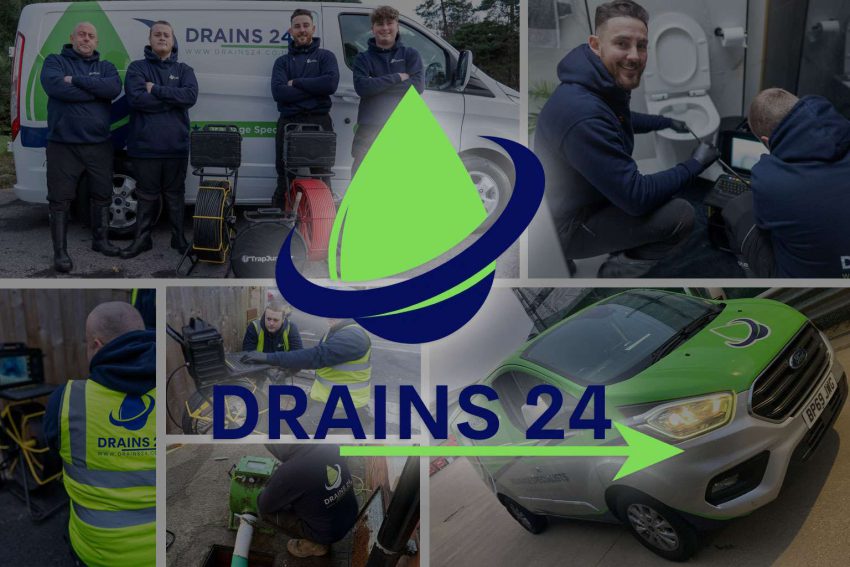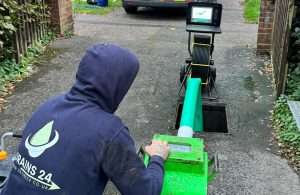Drain repairs don’t always require digging up your garden or driveway. Modern no-dig relining solutions allow damaged pipes to be restored quickly with minimal disruption.
In this real case study from Kingston upon Thames, Drains24 were called to investigate ongoing blockages at a residential property near Norbiton. What we discovered — and how we fixed it — showcases why pipe relining is one of the most effective repair methods available.
The problem — repeated blockages and slow drainage
The homeowner had faced slow-flowing drains for several months. Despite multiple basic clearances, the issue kept returning.
On arrival, our engineers carried out a CCTV drain survey, revealing:
- A fractured clay pipe around 12 metres from the chamber
- Fine tree roots entering through the crack
- Standing water collecting in a dipped pipe section
- Early signs of debris collecting around the damaged area
This combination meant the pipe was only partially functional — and likely to worsen without proper repair.
Why excavation wasn’t the best option
The damaged section was located beneath a landscaped patio that had been installed recently. Traditional excavation would have required:
- Removing the entire paved section
- Disruption to the garden
- Noise and heavy machinery
- Several days of labour
- Higher repair costs
To avoid unnecessary damage and cost, we recommended a modern CIPP (Cured-In-Place Pipe) relining solution.
The relining process — step by step
1. High-pressure cleaning
Before relining, we used WJA-approved water jetting to remove all debris and root ingress. This ensures the liner bonds correctly.
2. CCTV confirmation
A follow-up camera inspection confirmed the pipe was clean and ready for lining.
3. Preparing the resin liner
We measured the damaged pipe section and prepared a resin-impregnated liner sized to repair the fractured area.
4. Inversion and curing
The liner was inserted into the drain using compressed air (known as inversion). Once in position, the resin cured, creating a seamless new pipe inside the old one.
5. Final inspection
Another CCTV inspection confirmed a perfect seal — no cracks, no leaks, and smooth water flow.
The entire repair took only 3 hours, compared to two full days for excavation and reinstatement.
Why relining was the right choice for this Kingston home
This project highlights the many benefits of CIPP relining:
- No digging required
- Cost-effective compared to excavation
- Fast turnaround (same-day completion)
- Minimal disruption to gardens and outdoor spaces
- Strengthens the pipe and prevents future cracks
- Stops root intrusion permanently
These advantages make relining ideal for Kingston’s older clay pipe systems, especially in built-up or landscaped areas.
Local factors — why Kingston properties often need relining
Kingston has a mix of Edwardian, Victorian, and post-war housing. Many properties still rely on older clay drainage systems, which are prone to:
- Joint displacements
- Root intrusion
- Cracking from soil movement
- Water infiltration during heavy rainfall
Areas such as Surbiton, Norbiton, Coombe, and Berrylands frequently report drainage issues linked to aging pipework.
Expert repairs backed by industry standards
Our engineers are fully certified by:
- NADC (National Association of Drainage Contractors)
- WJA (Water Jetting Association)
- Local Thames Water-approved contractors
This ensures safe, compliant, high-quality work every time.
This Kingston case study proves that you don’t need excavation to fix major pipe issues.
📞 Call Drains24 for no-dig pipe relining and drain repairs in Kingston upon Thames.
We’re available 24/7 and offer fast, minimally disruptive solutions for all homes and businesses.
Drain Repairs FAQs
What is pipe relining and how does it work?
Pipe relining creates a new internal pipe using a resin liner, repairing cracks and restoring full flow without excavation.
Is pipe relining suitable for older Kingston properties?
Yes — relining is ideal for aging clay systems found across Kingston, Surbiton, and Norbiton, where cracks and root intrusion are common.
How long does the relining process take?
Most relining jobs take 2–4 hours, far quicker than excavation which can take days.
Does relining fix root intrusion permanently?
Yes — once relined, roots can no longer enter the pipe as all cracks and joints are sealed.
How long does a relined pipe last?
When installed professionally, a relined pipe typically lasts **50+ years** with minimal maintenance.




